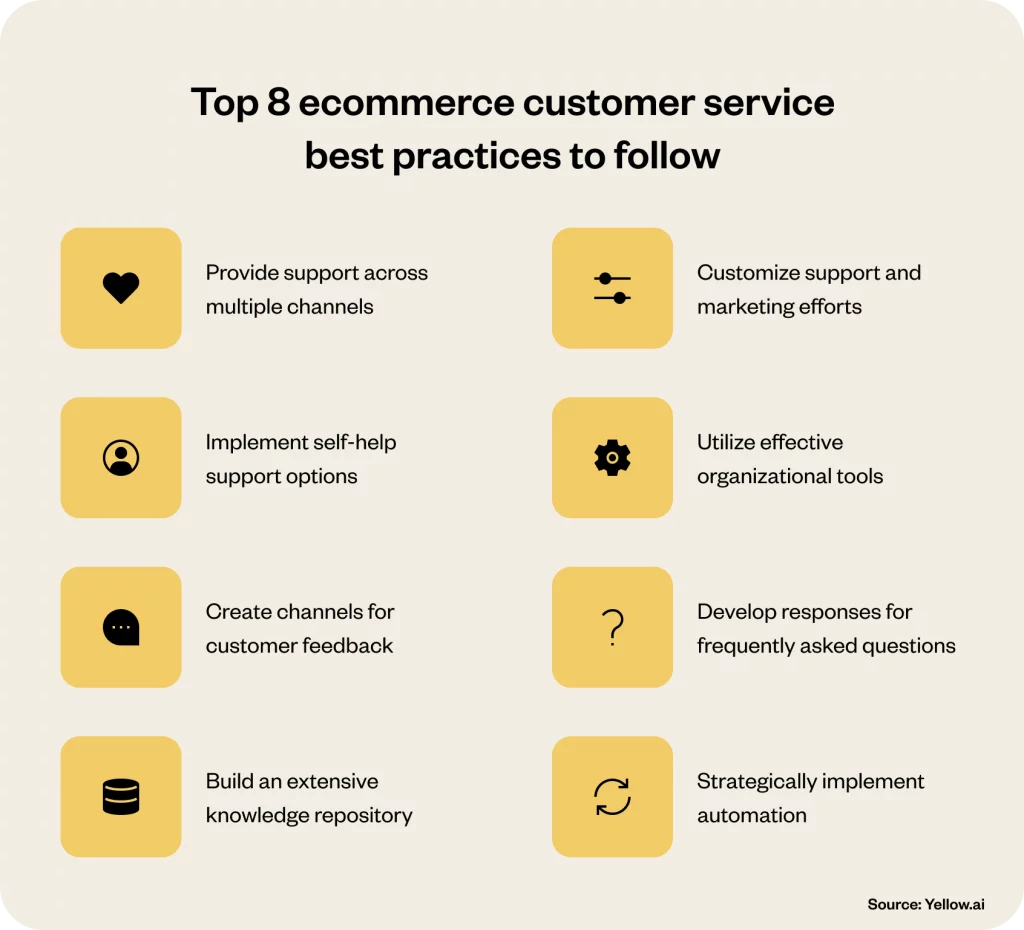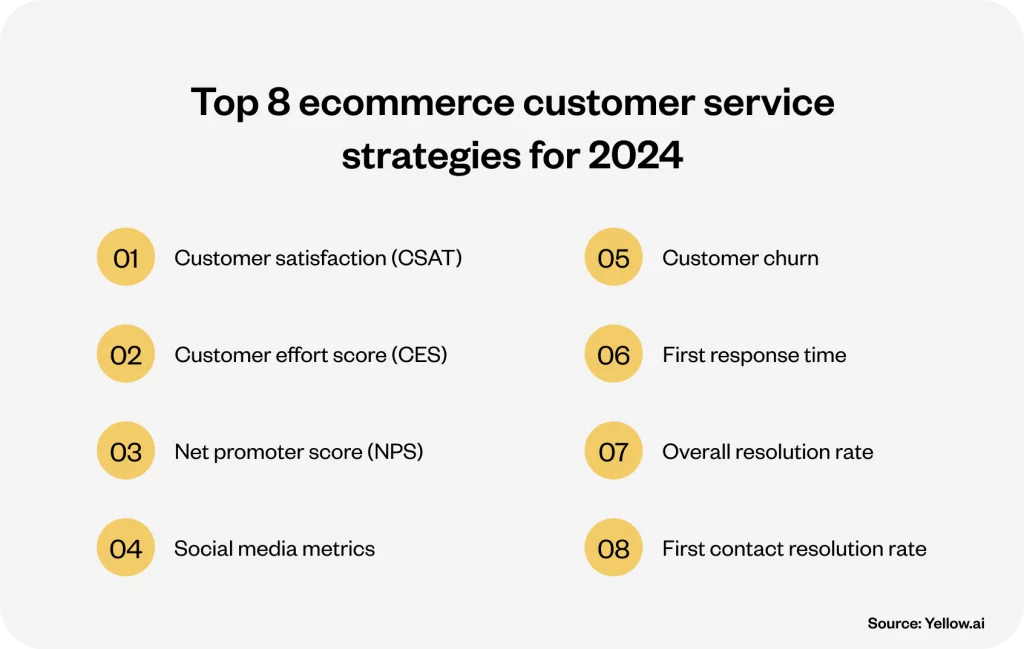Executive summary
The world of ecommerce is bustling, customer expectations are soaring, and brand loyalty is fleeting. Hence, exceptional customer service is becoming the not-so-secret sauce for success. This insightful blog gets into the core of ecommerce customer service, spotlighting eight transformative strategies that can redefine the shopping experience in 2024. From honing multi-channel support to leveraging AI, these practices heighten customer engagement and satisfaction. Drawing on the latest industry data, we explore how these approaches boost loyalty and sales while positioning businesses at the forefront of ecommerce innovation.
Introduction
The digital age has ushered in a new paradigm for customer service, especially in the ecommerce sector. With online shopping figures skyrocketing, businesses are now competing fiercely, not just in product offerings but in providing exceptional customer experiences. Step into the digital marketplace of 2024, where each customer interaction is not merely a transaction. Instead, it is a moment to build and enhance lasting loyalty and drive meaningful sales. In today’s era of ecommerce customer service, we’re witnessing a seismic shift from conventional support methods to innovative, empathetic customer engagement strategies. Gone are the days of one-size-fits-all solutions; today’s ecommerce landscape demands a nuanced, customer-centric approach.
Recent studies underscore this evolution: nearly 70% of consumers now say they’re more likely to switch brands if they do not get excellent customer service. However, almost 48% of consumers are willing to pay a premium for premium customer service. This blog is your roadmap to mastering these changing tides. We talk about eight advanced ecommerce customer service strategies, each underpinned by real-world data and trends. These tactics are about solving problems and crafting memorable experiences that resonate with customers and turn them into brand advocates. Read on, and let’s reshape the future of ecommerce customer service together.
Related must-reads:
- Conversational commerce: The complete guide to commerce solution [2024]
- The significance of conversational AI in retail
- Customer experience in retail: Strategies and the future of CX
- Top 10 customer service challenges in 2024
What is ecommerce customer service?
Ecommerce customer service is a pivotal pillar in the bustling landscape of online retail. It shapes the success of any digital storefront. This domain transcends traditional customer support roles, morphing into a dynamic, engaging, and empathetic interaction with every customer. Picture a virtual world where each inquiry or feedback is considered a golden opportunity to deepen customer loyalty and enrich their shopping journey. Ecommerce customer service goes beyond merely solving problems. In fact, it’s about crafting an experience that resonates with customers on a personal level, turning every interaction into a moment of trust-building and connection.
Related read: Customer service automation – A full guide
The ecommerce customer service in the current digital-first marketplace has evolved from a nice-to-have to a make-or-break aspect of business strategy. Citing a Microsoft study, an overwhelming 95% of consumers regard customer service as a key factor in their loyalty to a brand. This aspect of ecommerce encompasses a holistic approach to customer care, ensuring a smooth, cohesive experience across various touchpoints, from live chat and email support to social media interactions. It’s about being present where the customers are, ready to offer not just solutions but a memorable service experience that surpasses their expectations.
However, bridging the gap between perception and reality in service quality is a significant hurdle. The discrepancy is stark: while 87% of businesses believe in their exceptional service delivery, only 11% of customers concur. This gap highlights the urgent need for ecommerce businesses to reassess their customer service tactics and continually refine them critically. Remember, having a customer service system is the beginning, not the endpoint. It must be adaptive, empathetic, and attuned to the nuanced needs of today’s tech-savvy consumers.
Related read: 10 Best ecommerce platforms for your business in 2024
10 Benefits of good customer service in ecommerce
As the digital market swells, the significance of ecommerce customer service has never been more pronounced. Good customer service in the ecommerce sector is a critical differentiator in today’s highly competitive digital marketplace. It’s more than just about addressing queries; it’s about building a relationship with customers that extends beyond the purchase. Let’s explore the top ten benefits of exceptional ecommerce customer service and how each of them plays a pivotal role in the success of an online business.

1. Increased customer loyalty
Good ecommerce customer service fosters customer loyalty. When customers receive timely and empathetic support, they are more likely to return to the same online store for future purchases. This repeat business is crucial for sustainable growth. Loyal customers often transform into brand advocates, sharing their positive experiences with others, indirectly contributing to new customer acquisition.
Related read: Customer acquisition cost – 8 Ways to reduce your CAC
Example: Imagine a fashion ecommerce store that promptly addresses a customer’s concern about late delivery. The store rectifies the issue by offering a sincere apology and a discount on their next purchase. Also, it transforms the customer into a loyal advocate who frequently returns for their fashion needs, praising the brand’s responsiveness to peers.
2. Enhanced reputation
The quality of the customer service you provide can significantly influence your brand’s reputation. Positive customer experiences often lead to favorable reviews and testimonials, enhancing your brand’s image. A strong reputation attracts new customers and helps in building trust, which is essential for long-term business success.
Example: An electronic ecommerce platform consistently receives positive reviews for its quick and knowledgeable tech support. This reputation for excellent service attracts tech enthusiasts who value reliable support, significantly increasing the platform’s customer base.
3. Reduced returns and complaints
Effective customer service can significantly reduce the number of returns and complaints. By proactively understanding and addressing customer needs, businesses can avoid many common issues that lead to dissatisfaction. Fewer returns and complaints mean lower operational costs and a higher overall customer satisfaction rate.
Example: A home decor online retailer provides detailed product descriptions and responsive pre-purchase chat support, resulting in customers making well-informed decisions. This approach leads to a noticeable decrease in returns and complaints, as customers receive precisely what they expect.
4. Competitive edge
In the crowded ecommerce space, offering superior customer service can give your business a competitive edge. It differentiates your brand in a market where products and prices are often similar. This advantage can be the deciding factor for customers when choosing between your brand and a competitor.
Example: In the specialty foods market, an ecommerce business stands out by offering personalized recipe suggestions based on previous purchases. This unique touch delights food enthusiasts and gives the business an edge over competitors who only focus on sales.
5. Higher conversion rates
Good customer service can directly impact your conversion rates. When customers feel supported and valued, they are more likely to complete a purchase. Enhanced conversion rates lead to increased sales and revenue, driving business growth.
Example: An online bookstore uses customer service interactions to offer personalized reading recommendations. This approach not only enhances the shopping experience but also increases the likelihood of customers purchasing more books, boosting conversion rates.
6. Customer feedback and insights
Customer service interactions are a goldmine for valuable feedback and insights. They provide direct input from customers about what’s working and what’s not. This information is crucial for the continuous improvement of products, services, and customer experiences.
Related read: Customer experience vs customer service: More than just semantics
Example: A fitness equipment ecommerce site actively solicits customer feedback post-purchase. Insights gathered lead to the development of new, user-friendly fitness products, tapping into unmet customer needs and opening new market opportunities.
7. Increased customer lifetime value
Exceptional customer service increases the lifetime value of a customer. Satisfied customers tend to spend more over time and remain loyal to the brand. This long-term customer relationship is more profitable than constantly acquiring new customers.
Related read: What customer lifetime value (CLV) is & How to calculate?
Example: An online pet supply store offers exceptional post-purchase support and loyalty programs. Feeling valued and understood, pet owners continue to purchase their pets’ needs from this store over the years, increasing their lifetime value to the business.
8. Reduced marketing costs
Happy customers often become brand advocates. Word-of-mouth marketing from satisfied customers reduces the need for extensive advertising. This organic marketing approach lowers marketing costs while maintaining effective brand promotion.
Example: A beauty products ecommerce brand leverages user-generated content, encouraging customers to share their experiences on social media. This authentic customer advocacy acts as a powerful marketing tool, reducing the need for expensive ad campaigns.
9. Empowered employees
A strong focus on customer service empowers employees, giving them the tools and confidence to make decisions that benefit the customer. Empowered employees are more engaged, leading to better customer interactions and a positive workplace culture.
Related read: Employee experience: A complete guide for HR
Example: An online DIY tools retailer empowers its customer service team to make on-the-spot decisions like instant refunds or expedited shipping. This autonomy resolves issues quickly and leads to a motivated workforce passionate about delivering top-notch service.
10. Effective crisis management
Good customer service includes effective crisis management. Being prepared and responsive during a crisis can mitigate negative impacts. Effective crisis management preserves customer trust and loyalty, even in challenging situations.
Example: A travel accessories ecommerce business faced a supply chain disruption. By proactively informing customers, offering alternatives, or processing swift refunds, the business managed the crisis effectively, maintaining customer trust despite the challenges.
Top 8 ecommerce customer service best practices to follow
Ecommerce customer service is about creating an exceptional experience for every customer. Businesses should not limit it to only answering customer queries. With ecommerce evolving rapidly, adopting best practices in customer service is crucial for staying ahead. Here are eight best practices to elevate your ecommerce customer service in 2024.

1. Provide support across multiple channels
Today’s digitally equipped customers interact through various channels. Providing support across multiple channels like email, chat, social media, and phone ensures you meet your customers where they are most comfortable. This approach leads to increased accessibility and satisfaction.
Imagine your ecommerce store specializing in kitchen appliances experiencing a surge in inquiries during the holiday season. Customers are reaching out across various platforms – some prefer quick responses on social media, while others seek detailed advice over email. By diversifying your customer support to include social media and email, you cater to different preferences effectively. This multichannel approach streamlines communication and also enhances customer satisfaction, as each customer feels heard on their preferred platform.
Related read: Omnichannel vs multichannel – What’s the difference?
2. Customize support and marketing efforts
Personalization is vital in ecommerce. Tailoring support and marketing efforts based on individual customer data creates a more relevant and engaging experience. Customized support can lead to higher customer engagement and loyalty.
For instance, your online boutique has a diverse customer base with varied fashion tastes. Some customers are into vintage styles, while others prefer modern trends. Using customer purchase history and preferences, you create targeted marketing campaigns and customized support. When a vintage style lover contacts support, they receive suggestions on the latest retro collection. Such personalization can lead to increased engagement and higher sales.
3. Implement self-help support options
Many customers prefer finding answers themselves. Offering self-help options like FAQs or knowledge bases empowers customers to resolve issues quickly. It improves customer satisfaction and also reduces the load on your support team, allowing them to focus on more complex inquiries.
Imagine you run an online tech gadgets ecommerce store. Many customers, especially those less tech-savvy, frequently inquire about basic setup processes. Here, introducing an interactive self-help guide with step-by-step setup instructions can significantly reduce these routine inquiries. It will empower customers to find answers independently, enhancing their experience and freeing up your support team for more complex issues.
Related read: 7 Tips for customer self-service
4. Utilize effective organizational tools
Efficient organization of customer queries and information is crucial. Tools like CRM systems help manage customer interactions effectively. Organizational tools streamline operations and ensure no customer query is missed, leading to a more efficient and error-free service.
Imagine that your online pet supplies store receives repeated inquiries from customers with ongoing orders. By implementing a CRM system, your support team can have immediate access to each customer’s order history and status. It will lead to quicker, more informed responses, improving customer satisfaction and reducing response times.
5. Create channels for customer feedback
Feedback is invaluable for continuous improvement. Creating accessible channels for customers to provide feedback shows that you value their opinions. Actively seeking and acting on feedback can enhance customer satisfaction and help in making informed decisions about your product and service offerings.
For instance, as an online sports equipment retailer, you notice varied feedback on product pages regarding equipment usability. Here, setting up a dedicated feedback channel will allow customers to share their experiences and suggestions. This input will help you refine product descriptions and usability guides, leading to better-informed customers and fewer product returns.
Related read: Customer sentiment analysis in 2024: How-to guide
6. Develop responses for frequently asked questions
Having ready-made responses to common queries can significantly speed up your customer service. This practice improves response times and also ensures consistency and accuracy in the information provided, enhancing the overall customer experience.
Suppose your online gardening store frequently receives questions about plant care and suitable gardening tools. In such cases, developing a comprehensive FAQ section addressing these common questions will provide immediate answers to customers and enhance their shopping experience. It will also reduce the workload on your customer service team.
7. Build an extensive knowledge repository
A comprehensive knowledge base helps both customers and customer service agents. It serves as a reliable source of information on various topics. An extensive knowledge repository can significantly reduce the time taken to resolve issues, leading to quicker and more effective customer service.
Imagine customers of your online bookstore often seek recommendations and detailed information about genres and authors. To help them, you can create an extensive knowledge repository with author bios, book reviews, and genre guides that enable customers to explore and discover on their own. It will enrich their shopping experience and foster a sense of community.
8. Strategically implement automation
Automation, when used strategically, can enhance the efficiency of customer service. Automated responses, chatbots, and AI can handle routine inquiries effectively. Automation can lead to faster resolutions of simple queries, freeing human agents to handle more complex issues and personalize the customer experience where it matters most.
Related read: Customer Service Chatbots – Benefits and Examples
Imagine this scenario. During major sales events, your online electronics store faces a high volume of basic inquiries like stock availability and shipping times. You can implement an AI chatbot to handle these basic inquiries in such a case. It will free your human support team to tackle more complex customer issues. This strategic use of automation will enhance efficiency and ensure a smoother customer experience during peak times.
Empower your customers with a support experience like no other

How to measure customer service success in ecommerce
Measuring the success of customer service is crucial in the ecommerce sector. It helps businesses understand the impact of their customer service strategies and make informed decisions. Here are key metrics and their implications:

1. Customer satisfaction (CSAT): CSAT is the immediate pulse check on how customers feel after an interaction with your brand. It’s like a quick temperature check that tells you if customers are warm and happy or cold and disappointed after their interaction.
Related read: How to boost customer satisfaction with Yellow.ai
2. Customer effort score (CES): CES measures how easy it was for customers to resolve their issues or their needs met. It’s like rating the smoothness of a road trip – whether it is bumpy and cumbersome or smooth and effortless.
3. Net promoter score (NPS): NPS reveals how likely customers are to recommend your service or product. Think of it as the likelihood of your customers turning into your brand ambassadors.
4. Social media metrics: These metrics gauge customer engagement and sentiment on social platforms. It’s like having a stethoscope to the ground on social media, listening to the heartbeat of customer opinions.
Related read: 12 Customer Service Metrics to Measure in 2024
5. Customer churn: This measures how many customers you’re losing over time. It’s a reality check, like watching guests at a party – who’s sticking around, and who’s heading for the door?
6. First response time: This tracks how quickly your team responds to customer inquiries. It’s like measuring the speed of your service – are you a speedy cheetah or a slow-moving sloth?
7. Overall resolution rate: This measures how many customer issues get resolved out of the total received. It’s tallying your victories – how often are you crossing the finish line with a solution?
8. First contact resolution rate: It gauges how often customers get their issues resolved in the first interaction. It is about hitting the bullseye in the first attempt. Are you a sharpshooter in solving issues promptly?
How Yellow.ai can enhance your ecommerce customer service?
Staying ahead in ecommerce means embracing technological advancements that enhance customer experience. Yellow.ai stands out with its state-of-the-art technology, designed to revolutionize customer service interactions. Here are the top features of Yellow.ai that align perfectly with the needs of any ecommerce business:
Advanced Natural Language Processing (NLP): Yellow.ai’s chatbots are powered by sophisticated NLP. It enables them to understand and respond to customer inquiries with human-like precision. This technology ensures that interactions are natural, intuitive, and efficient.
AI-driven personalization: The platform harnesses AI to analyze customer data, enabling personalized interactions and recommendations. It leads to a more engaging customer experience, as each interaction is tailored to the individual’s preferences and history.
Seamless integration with ecommerce platforms: Yellow.ai’s solutions integrate smoothly with existing ecommerce platforms, ensuring a cohesive experience for both customers and service teams. This integration facilitates real-time data sharing and enhances overall operational efficiency.
Scalable solutions: As your ecommerce business grows, Yellow.ai’s technology scales with you. Whether dealing with a surge in customer queries or expanding to new markets, the platform adapts to meet changing demands without compromising on service quality.
Actionable insights and analytics: Beyond handling customer interactions, Yellow.ai provides valuable insights through analytics. These insights help businesses understand customer behavior and preferences, enabling more informed strategic decisions.
Step into the future of ecommerce customer service with Yellow.ai. Explore and experience the technology first hand – book your demo today.
The final thoughts
The landscape of online retail is ever-evolving. So, let’s envision a future where each customer interaction becomes a masterpiece of engagement and satisfaction. Imagine a world where every query is an opportunity to dazzle and every complaint a chance to win a customer for life. It is the future that Yellow.ai is helping shape—a world where technology and human empathy blend seamlessly to create extraordinary customer experiences.
In this future, ecommerce isn’t just about transactions; it’s about creating stories, experiences, and relationships that endure. It’s a future where businesses don’t just meet expectations—they exceed them, one customer at a time.
Frequently asked questions (FAQs)
What are the 3 types of ecommerce?
There are three foundational categories in ecommerce. Business to Consumer (B2C) is where businesses sell products or services directly to customers. Then, business-to-business (B2B) is about all transactions between different businesses. The third is consumer-to-consumer (C2C), which refers to transactions where individuals sell directly to other individuals through marketplaces.
How do I provide customer support for ecommerce?
To provide adequate ecommerce customer support, implement multichannel communication, offer self-service options like FAQs, personalize interactions based on customer data, use customer feedback for continuous improvement, and ensure your team is trained in both product knowledge and customer service skills.
Why is customer service of ecommerce important?
Customer service in ecommerce is crucial as it directly impacts customer satisfaction, loyalty, and brand reputation. It’s a key differentiator in the competitive online marketplace and can influence customer purchase decisions and their likelihood to recommend your brand to others.
What are the five main support areas of ecommerce?
The five main support areas in ecommerce include query resolution (addressing customer questions), technical support (assisting with a website or product issues), order management (handling orders, shipping, and tracking), returns and refunds processing, and proactive customer engagement (providing updates and offers).
How do you handle an angry customer?
To handle an angry customer, listen empathetically to their concerns, apologize sincerely, offer a timely and effective solution, and follow up to ensure their issue has been resolved to their satisfaction. Use the feedback to improve your services and prevent future grievances.

























